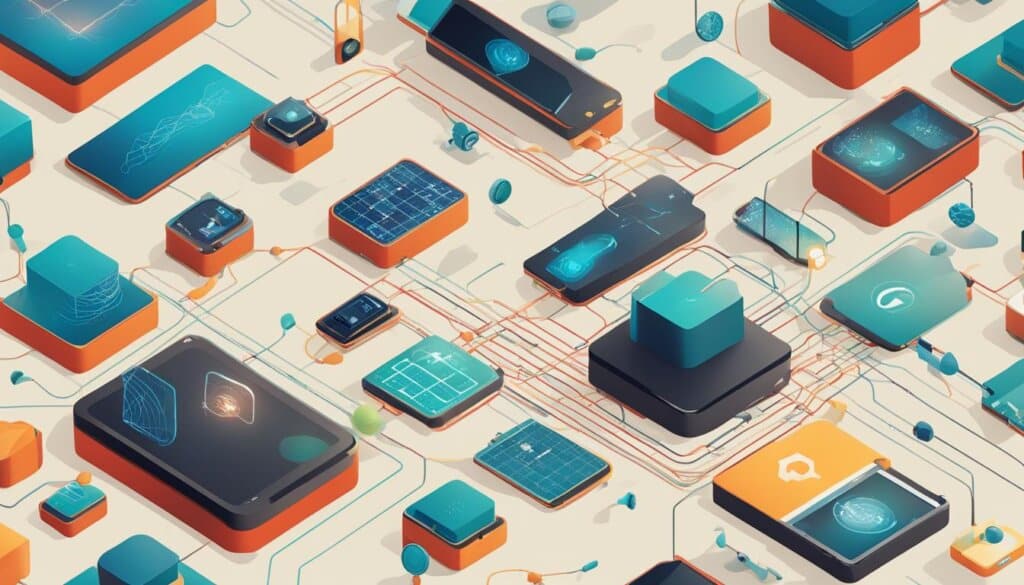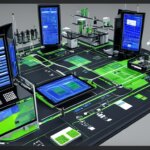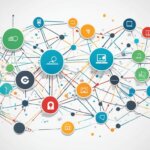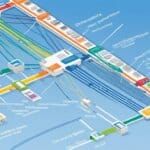Table of Contents
IoT devices, short for Internet of Things devices, are nonstandard computing hardware that connect wirelessly to a network and can transmit data. These devices extend internet connectivity beyond typical computing devices, allowing them to communicate and interact over the internet.
In both industrial and consumer settings, IoT devices play a crucial role. They can be seamlessly integrated into various tools such as mobile devices and industrial equipment, enhancing connectivity and enabling efficient data transmission.
Examples of IoT Devices
IoT devices encompass a wide range of applications across various sectors. They can be broadly categorized into three main groups: consumer-connected devices, enterprise IoT devices, and industrial IoT devices.
Consumer-Connected Devices
Consumer-connected devices are designed for personal use and provide smart, convenient functionalities in daily life. From smart TVs and speakers to wearables and toys, these devices enhance the user experience by connecting to the internet and enabling seamless communication and control.
- Smart TVs: These internet-enabled televisions offer interactive features, streaming services, and personalized content.
- Smart Speakers: Devices like Amazon Echo and Google Home use voice recognition technology to provide information, play music, control smart home devices, and more.
- Wearables: Devices such as fitness trackers and smartwatches monitor health, track physical activities, and provide notifications.
- Smart Appliances: Connected refrigerators, thermostats, and lighting systems enable remote control and automation, promoting energy efficiency and convenience.
Enterprise IoT Devices
In the business world, enterprise IoT devices play a crucial role in enhancing efficiency, productivity, and cost-effectiveness. They are used for a wide range of applications, including facility management, data collection, and optimization of business processes.
- Facility Maintenance: IoT devices are utilized for monitoring and controlling various aspects of buildings, such as HVAC systems, lighting, and security.
- Meeting Scheduling: Smart conference room systems integrate IoT technology to streamline scheduling, automate room setup, and enable remote collaboration.
- Asset Tracking: IoT devices can track the location and condition of assets, optimizing inventory management and reducing loss or theft.
Industrial IoT Devices
Industrial IoT devices, also known as Industrial Internet of Things (IIoT) devices, are designed for use in factories and manufacturing environments. These devices enable real-time monitoring, predictive maintenance, and overall optimization of industrial processes.
- Monitoring Systems: IIoT devices monitor machine performance, collect data, and provide insights for preventive maintenance, reducing downtime and improving overall efficiency.
- Sensor Networks: IoT sensors are used to measure temperature, pressure, humidity, and other variables to ensure quality control and safety in manufacturing processes.
- Predictive Analytics: By analyzing data from IoT devices, predictive analytics algorithms can identify potential issues before they occur, enabling proactive decision-making and minimizing disruptions.
Examples of Consumer-Connected, Enterprise, and Industrial IoT Devices:
| Consumer-Connected Devices | Enterprise IoT Devices | Industrial IoT Devices |
|---|---|---|
| Smart TVs | Facility Maintenance Systems | Monitoring Systems |
| Smart Speakers | Meeting Scheduling Systems | Sensor Networks |
| Wearables | Asset Tracking Devices | Predictive Analytics Tools |
| Smart Appliances |
These examples illustrate the diverse applications of IoT devices across different sectors. As technology continues to advance, IoT devices are reshaping the way we live, work, and operate businesses.
How IoT Devices Work
IoT devices are physical objects embedded with technology such as sensors and software. They collect and send data through an IoT gateway where it can be analyzed. IoT devices can communicate with each other and perform tasks without human intervention. They connect to the internet and can be managed through software applications or integrated web servers.
The Components of IoT Devices
IoT devices consist of various components that enable their functionality:
- Physical objects: IoT devices can take the form of everyday objects such as thermostats, fitness trackers, or even cars.
- Embedded systems: IoT devices are equipped with embedded systems that include microcontrollers, sensors, and actuators. These components allow the devices to collect data, process information, and perform actions based on predefined instructions.
- Sensor data: IoT devices rely on sensors to capture data from the surrounding environment. This data can include information such as temperature, humidity, motion, and more.
- IoT gateway: The IoT gateway serves as the bridge between the IoT devices and the internet. It enables data transmission, connectivity, and security protocols.
- Data analysis: Once the data is transmitted through the IoT gateway, it can be analyzed using various data analysis techniques. This analysis helps derive useful insights, patterns, and trends from the collected data.
“IoT devices seamlessly integrate physical objects, embedded systems, sensor data, IoT gateways, and data analysis to enable automation, data-driven decision-making, and enhanced efficiency.”
IoT devices operate autonomously, performing tasks and making decisions based on the collected data and predefined rules. They can also communicate with other IoT devices, forming a network that enables collaborative actions and complex systems. By connecting to the internet, IoT devices can be remotely monitored, controlled, and updated, enhancing their functionality and adaptability.

Understanding how IoT devices work is crucial for harnessing their potential in various industries. In the next section, we will explore the management of IoT devices, including onboarding, configuration, maintenance, diagnostics, and firmware updates.
IoT Device Management
IoT device management plays a crucial role in integrating, organizing, monitoring, and remotely managing internet-enabled devices. It encompasses various categories, including onboarding devices, configuration, maintenance, diagnostics, and end-of-life management. Effective device management ensures the smooth operation and optimal performance of IoT devices throughout their lifecycle.
One of the key aspects of IoT device management is the onboarding process. It involves securely connecting new devices to the network, authorizing their access, and assigning unique identifiers. Proper onboarding ensures that devices are authenticated and can seamlessly communicate with other devices and the network.
Configuration management is another vital component of IoT device management. It involves setting up and maintaining the desired configurations for each device. This includes configuring network settings, security parameters, device-specific settings, and software updates. Effective configuration management ensures consistency and enables centralized control over the IoT devices.
Maintenance is an ongoing process for managing IoT devices. It involves monitoring their performance, detecting and resolving issues, and optimizing their operation. Real-time diagnostics help identify potential problems and enable proactive troubleshooting. By implementing regular maintenance procedures, organizations can minimize device downtime and maintain the overall health of their IoT ecosystem.
Regular firmware updates are essential for ensuring the security, stability, and performance of IoT devices. Firmware is the software embedded in the device’s hardware that controls its operation. Upgrading firmware helps fix bugs, patch security vulnerabilities, introduce new features, and improve overall device performance. IoT device management systems facilitate the seamless distribution and installation of firmware updates across a fleet of devices.
Effective device management processes streamline the entire lifecycle of IoT devices, from initial onboarding to ongoing configuration, maintenance, and firmware updates. By implementing robust management practices, organizations can ensure the successful operation of their IoT ecosystem, improve device performance, and mitigate security risks.
| Category | Description |
|---|---|
| Onboarding Devices | Securely connecting new devices to the network and authorizing their access. |
| Configuration | Setting up and maintaining the desired configurations for each device. |
| Maintenance | Monitoring device performance, detecting and resolving issues, and optimizing operation. |
| Diagnostics | Real-time monitoring and troubleshooting to identify and address potential problems. |
| Firmware Updates | Distributing and installing firmware updates to enhance device security and performance. |
IoT Device Connectivity and Networking
IoT devices rely on diverse networking protocols and wireless technologies to establish connectivity and enable seamless communication. This section explores the various networking protocols, wireless protocols, and connectivity options available for IoT devices, as well as the role of IoT gateways and data processing in the IoT ecosystem.
Networking Protocols
Networking protocols play a crucial role in facilitating communication between IoT devices and the wider network infrastructure. Some commonly used networking protocols for IoT devices include:
- Constrained Application Protocol (CoAP): CoAP is a lightweight application-layer protocol that enables efficient communication between constrained devices and the internet. It is designed for resource-constrained networks and devices, making it ideal for IoT applications.
- Datagram Transport Layer Security (DTLS): DTLS provides secure communication for IoT devices by encrypting data transmitted over unreliable datagram transport protocols. It ensures the confidentiality and integrity of data exchanged between devices and servers.
- MQTT (Message Queuing Telemetry Transport): MQTT is a publish-subscribe messaging protocol widely used in IoT deployments. It allows devices to send data to one or more subscribers, enabling efficient and scalable communication across distributed networks.
Wireless Protocols
Wireless protocols provide the means for IoT devices to connect to networks without the need for physical cables. Some popular wireless protocols used in IoT include:
- Wi-Fi: Wi-Fi enables high-speed wireless communication and is widely available in both consumer and industrial settings. It provides reliable connectivity for IoT devices within a local area network (LAN).
- Cellular: Cellular networks, such as 4G LTE and 5G, offer wide coverage and enable IoT devices to connect to the internet from anywhere with cellular network coverage.
- Satellite: Satellite communication is used in scenarios where IoT devices need to connect in remote or rural areas with limited terrestrial network coverage.
IoT Gateway and Data Processing
An IoT gateway acts as a bridge between IoT devices and the cloud or backend systems. It collects data from connected devices, performs preliminary data processing tasks, and transmits the data to the appropriate destination for further analysis.
Some IoT devices have integrated data processing capabilities, allowing them to perform data filtering, aggregation, and analysis locally. This reduces the amount of data that needs to be transmitted to the cloud, minimizing network congestion and optimizing bandwidth usage.
Here is an example of an IoT gateway and its role in the IoT ecosystem:
An IoT gateway, such as the Amazon Web Services (AWS) IoT Greengrass, enables IoT devices to securely connect to the cloud and provides local data processing capabilities. It allows devices to run AWS Lambda functions, deploy machine learning models, and manage device fleets remotely. This local processing capability reduces latency, enhances security, and enables real-time analysis at the edge.
Security Risks of IoT Devices
IoT devices bring about significant security risks for both individuals and organizations. One major concern is the increased attack surfaces that come with the proliferation of these devices. With more endpoints connected to a network, hackers have greater opportunities to exploit vulnerabilities and gain unauthorized access.
Furthermore, unsecured hardware adds another layer of risk. IoT devices often have limited security measures in place, making them vulnerable to attacks. Weak passwords, outdated firmware, and lack of encryption can leave devices and sensitive data exposed to malicious actors.
Additionally, unencrypted data transmissions pose a serious threat to the security of IoT devices. When data is transmitted without encryption, it can be easily intercepted and manipulated by attackers. This puts confidential information at risk, including personal data, financial details, and proprietary business information.
To safeguard IoT devices, it is crucial to implement robust security measures. This includes authentication mechanisms to ensure only authorized users can access the devices, encryption of data transmissions to protect information in transit, and network segmentation to isolate critical systems from potential breaches. Strong and unique passwords should also be employed to prevent unauthorized access. Adopting standard protocols and frameworks designed specifically for IoT security can further enhance the protection of these devices and mitigate potential risks.
FAQ
What are IoT devices?
IoT devices are nonstandard computing hardware that connect wirelessly to a network and can transmit data.
How are IoT devices categorized?
IoT devices can be categorized into three main groups: consumer, enterprise, and industrial.
What are examples of consumer-connected IoT devices?
Consumer-connected devices include smart TVs, smart speakers, toys, wearables, and smart appliances.
How do IoT devices work?
IoT devices are physical objects embedded with technology such as sensors and software. They collect and send data through an IoT gateway where it can be analyzed.
What is IoT device management?
IoT device management helps integrate, organize, monitor, and remotely manage internet-enabled devices. It includes categories such as onboarding devices, configuration, maintenance, diagnostics, and end-of-life management.
How can IoT devices be connected to networks?
IoT devices can connect to networks such as cellular, satellite, Wi-Fi, and Ethernet. They can send data to an IoT gateway for analysis and some have integrated data processing capabilities.
What are the security risks associated with IoT devices?
IoT devices pose security risks, including increased attack surfaces and the potential for hackers to steal confidential information. Unsecured hardware, poor asset management, and unencrypted data transmissions can also compromise the security of IoT devices.













